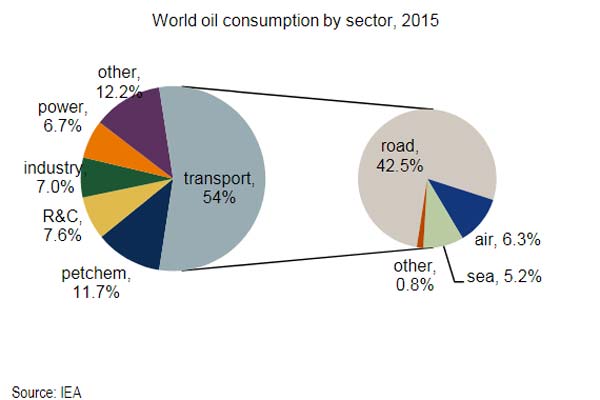
Driven by EVs, oil demand growth will peak by 2030: report
DUBAI, January 22, 2018
Electric vehicles (EV) are expected to take off rapidly in the early 2020s, resulting in a drastic slowdown in oil demand growth and causing global oil demand to peak by 2030, says Bank of America Merrill Lynch’s Global Energy Weekly report.
Oil is a transport fuel, and for the past five decades, growth in oil demand has primarily been driven by growth in global demand for transport. This means today just over half (54 percent) of global oil demand is consumed in transport, up by 20ppt since 1990, the report said.
Five decades ago, oil was widely used in other sectors, including power generation, industry and residential and commercial heating, but over the decades cheaper substitutes such as gas and coal were found for these uses. Oil lost market share to become a marginal fuel in most of these sectors, and over time oil has become relegated to mainly two sectors, transport and petchems, in which viable alternatives did not exist. Now all that is about to change, it said.
EVs gain massive momentum
Given oil's price premium over other primary fuels, the hunt for alternative transport fuels isn't new. Especially in the 1980s, the recent memory of two oil crises sparked renewed interest for EVs, yet despite many attempts by various companies no one managed to refine the concept to the point that it became a viable alternative to the combustion engine. The EVs developed then suffered hugely from lack of power and range, and this stigma of past failed attempts remained attached to EVs until fairly recently. So when EV manufacturers like Tesla in the early 2000s started tinkering with adapting recent advances in battery technology for cellphones and laptops for the vehicles market, they not only had to make huge technical progress to make EVs viable, they also had a big job to change consumers' preconceived notions that EVs were massively inferior to conventional vehicles. They managed both, the report said.
Battery technology has come a long way in the past 10 years. From 2010 to 2015 battery production costs fell on average by about 50%, and some producers like General Motors expect them to continue to decline in line with this recent trend.
BofA Merrill Lynch Global Research auto analysts project a cost decline of 25-30% every five years to 2030 and that means the crossover - when electric vehicles are equivalent to comparable internal combustion engine (ICE) vehicles on a total cost basis - could occur in 2023 at current forward prices of around $60/bbl for Brent crude oil.
Also, the range of EVs is becoming less of an issue, rising from 225km on average in 2017 to 350km by 2023, on our auto analysts' projections. "If we take into account current subsidy regimes, then EVs are already close to total cost equivalent with ICE in 2018, and if costs continue to decline then the subsidies could gradually be phased out to 2023 when EVs break even without subsidies. From then on, any further cost reduction would simply make EVs more competitive than ICE and should help proliferate them globally, eventually displacing conventional car sales almost completely," the report said.
The analysts now expect EVs to take off very rapidly in the early 2020s, rising from 5% of sales in 2020 to 40% of sales by 2030 and to 95% of sales by 2050. If EVs with current subsidies are already at cost breakeven with conventional vehicles in 2018, how come they don't take off before the 2020s? The answer is that auto manufacturers simply can't ramp up the capacity that quickly. Auto manufacturers usually plan their plants and equipment at five-year intervals, which correspond to the mandated Corporate Average Fuel Efficiency (CAFE) targets that they have to meet every year. In the US, the current CAFE phase spans model years 2017-2021, so EV sales will remain capped at a capacity of around max 5% of sales to 2021, the report said.
The key question is what car manufacturers are now planning to produce in 2022-27, and most from Detroit to Shanghai are investing for a big ramp-up in EV production in the 2020s, it said.
Oil demand will peak by 2030
The proliferation of EVs in the 2020s means that oil demand growth will begin to slow drastically in the early 2020s and turn outright negative before the end of the decade. In other words, global oil demand will peak by 2030, the report adds.
In DMs oil demand already peaked around 2005 on ever-rising fuel efficiency and slow growth in transport demand in these car-saturated markets. As transport demand rises in EMs over the decades to come, most of that growth will come from EVs, not oil-fuelled cars, and so oil demand in EMs will peak around 2035, on our estimates. True, in the early stages of EV proliferation, DMs will probably see a larger switch from conventional to EVs, in part due to better infrastructure. But as we see EVs hit cost breakeven with conventional they will proliferate in EMs alike.
BofA Merrill Lynch Global Research auto analysts expect half of the global EV sales to be in China alone by 2030. Once the entire car fleet has switched to EVs, EM oil demand may start growing again towards the end of the forecast horizon in the 2050s, on petchem demand and non-road-based transport (e.g. air travel), the analysts said. - TradeArabia News Service







